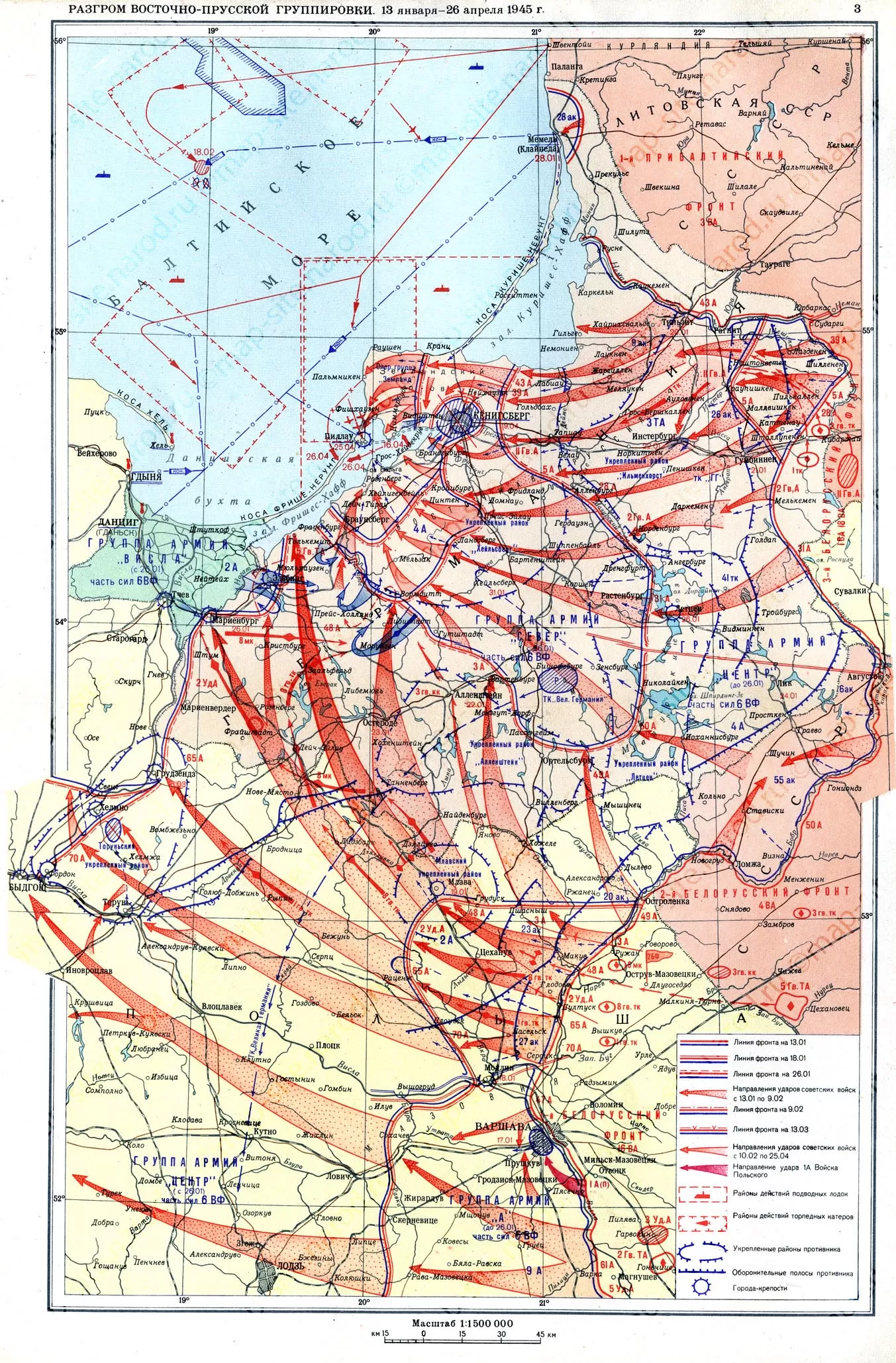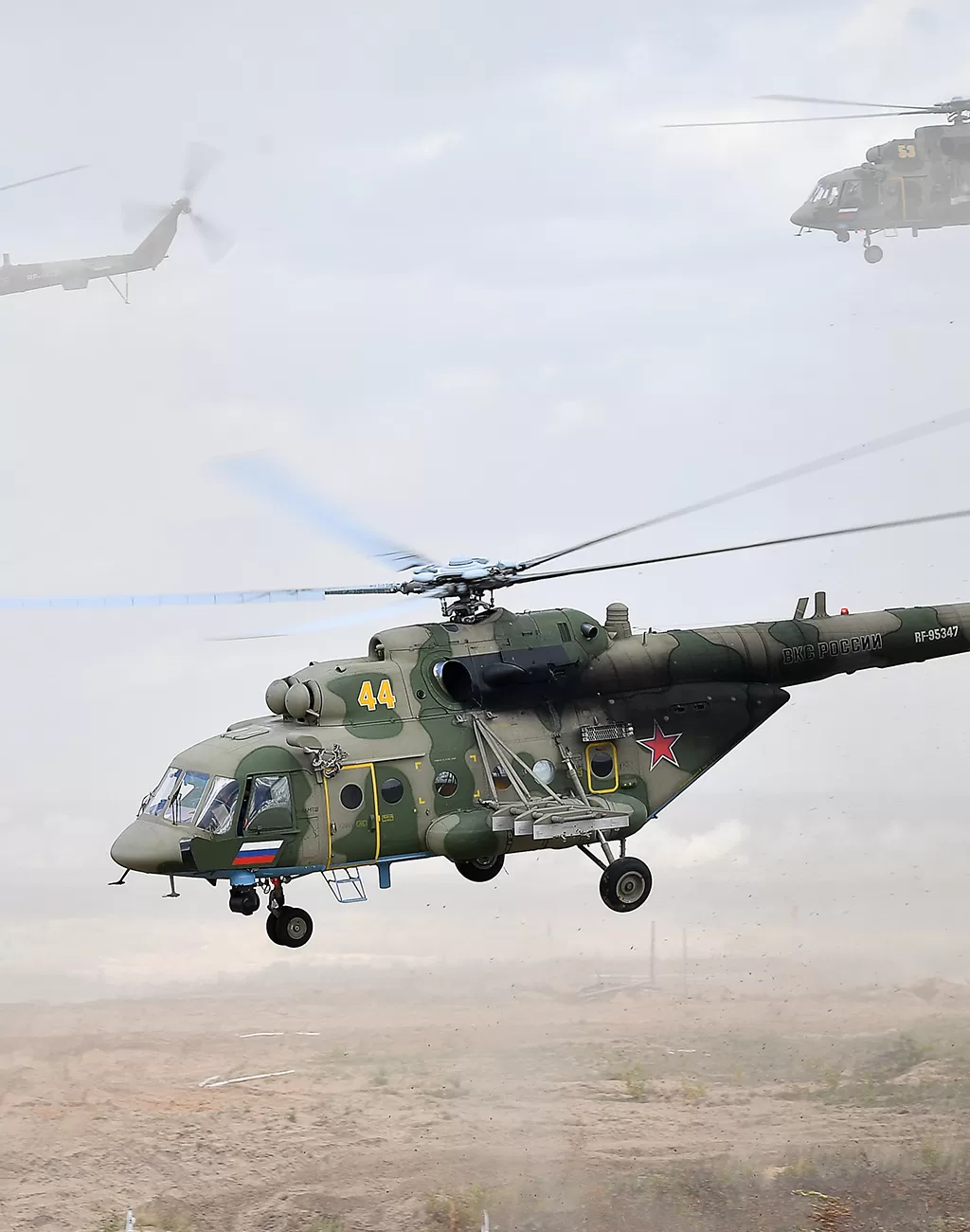
Battle for East Prussia in 1945, part 2
Soviet infantry, supported by self-propelled guns SU-76, attacked German positions in the area of Koenigsberg.
The command of the Army Group "North" made efforts to release the blockade of Koenigsberg and restore land communications with all army groups. South-west of the city, in the Brandenburg region (Russian Ushakovo), concentrated the 548th People's Grenadier Division and the Great Germany Panzergrenadier Division,
which were used on January 30 to strike north along the Vistula Lagoon. The German 5th Panzer Division and the 56th Infantry Division attacked from the opposite direction. They managed to force part of the 11th Guards Army to withdraw and break through a corridor about one and a half kilometers wide to Koenigsberg, which was under fire from Soviet artillery.
On January 31, General Ivan D. Chernyakhovsky came to the conclusion that it was impossible to capture Koenigsberg from the march: It became clear that uncoordinated and poorly prepared attacks on Koenigsberg (mainly in terms of logistical protection) would not lead to success, but, on the contrary, would give time the Germans to improve their defenses. First of all, it was necessary to demolish the fortifications of the fortress (forts, combat bunkers, fortified areas) and disable their fire system. And for this, the right amount of artillery was needed - heavy, large and high power, tanks and self-propelled guns, and, of course, a lot of ammunition. Careful preparation of troops for an assault is impossible without an operational break.
The following week, the divisions of the 11th Guards Army, "repelling the furious attacks of the Nazis," fortified their positions and switched to their daily attacks, trying to reach the shores of the Vistula Lagoon. On February 6, they again crossed the highway, definitely blocking Krulevets from the south - however, after that, 20-30 soldiers remained in the infantry companies. The troops of the 39th and 43rd armies in fierce battles pushed the enemy divisions deep into the Sambia Peninsula, creating an external encirclement front.
On February 9, the commander of the 3rd Belorussian Front ordered the troops to go over to a decisive defense and prepare for a methodical assault.
In the center, the 5th and 28th armies advanced in the Kreuzburg (Russian: Slavskoe) - Preussish Eylau (Ilava Pruska, Russian: Bagrationovsk) belt; on the left flank, the 2nd Guards and 31st Armies, having forced the Lyna, moved forward and captured the nodes of resistance Legden (Russian Good), Bandel and the large road junction Landsberg (Gurovo Ilavetske). From the south and west, the armies of Marshal K.K. Rokossovsky pressed on the Germans. Cut off from the mainland, the Lidzbar-Warmian enemy grouping could communicate with the Germans only on the ice of the lagoon and further along the Vistula Spit to Gdansk. The wooden covering of "everyday life" allowed the movement of cars. Masses of refugees were drawn to the flood in an endless column.
The German fleet carried out an unprecedented rescue operation, using everything that could remain afloat. By mid-February, 1,3 million out of 2,5 million inhabitants had been evacuated from East Prussia. At the same time, the Kriegsmarine provided artillery support to the ground forces in the coastal direction and was intensively engaged in the transfer of troops. The Baltic Fleet failed to break or even seriously interfere with enemy communications.
Within four weeks, most of the territory of East Prussia and northern Poland was cleared of German troops. During the fighting, only about 52 4,3 people were taken prisoner. officers and soldiers. Soviet troops captured over 569 thousand guns and mortars, XNUMX tanks and assault guns.
German troops in East Prussia were cut off from the rest of the Wehrmacht and divided into three groups isolated from each other. The first, consisting of four divisions, was squeezed into the Baltic Sea on the Sambia Peninsula; the second, consisting of more than five divisions, as well as units from the fortress and many separate units, was surrounded in Königsberg; the third, consisting of about twenty divisions of the 4th Army and the 3rd Panzer Army, was located in the Lidzbarsko-Warminsky fortified area, located south and southwest of Krulevets, occupying an area about 180 km wide along the front line and 50 km deep.
The evacuation of these troops under the cover of Berlin was not allowed by Hitler, who argued that only on the basis of fortified areas supplied from the sea and stubbornly defending and scattered groups of German troops would it be possible to forge very large forces of German troops. Red Army for a long time, which would prevent their redeployment to the Berlin direction. The Soviet Supreme High Command, in turn, expected that the release of the armies of the 1st Baltic and 3rd Belorussian fronts for other tasks was possible only as a result of the rapid and decisive liquidation of these groupings.
Most of the German generals could not understand this Hitlerian logic. On the other hand, Marshal K.K. Rokossovsky did not see the point in Stalin’s demands: “In my opinion, when East Prussia was finally isolated from the West, it was possible to wait for the liquidation of the German army group surrounded there, and due to the strengthening of the weakened 2nd Belorussian front, speed up the decision on the Berlin direction. Berlin would have fallen much sooner. It so happened that at the decisive moment, ten armies were occupied by the East Prussian grouping (...) The use of such a mass of troops against the enemy (...), remote from the place where the decisive events took place, in the situation that arose in the Berlin direction, was meaningless.
Ultimately, Hitler was right: of the eighteen Soviet armies involved in the liquidation of the German coastal bridgeheads, only three managed to take part in the "major battles" of the spring of 1945.
By the decision of the Headquarters of the Supreme High Command of February 6, the troops of the 1st and 2nd Baltic Fronts, blocking the Kurland Army Group, were subordinated to the 2nd Baltic Front under the command of Marshal L. A. Govorov. The task of capturing Koenigsberg and completely clearing the Sambian Peninsula of the enemy was assigned to the headquarters of the 1st Baltic Front, commanded by General of the Army Ivan Ch. Bagramyan, who was transferred from the 3rd Belorussian Front to three armies: the 11th Guards, 39th and 43 th and 1st tank corps. In turn, Marshal Konstantin Konstantinovich Rokossovsky on February 9 received a directive on the transfer to General of the Army Ivan Dmitrievich Chernyakhovsky of four armies: the 50th, 3rd, 48th and 5th Guards Tank. On the same day, General Chernyakhovsky was ordered, without giving either the Germans or his troops a respite, to complete the defeat of the 20th Army of General Wilhelm Muller by infantry no later than February 25-4.
As a result of bloody, uncompromising and uninterrupted battles, - recalls Lieutenant Leonid Nikolayevich Rabichev, - both our and German troops lost more than half of their manpower and began to lose combat effectiveness due to extreme exhaustion. Chernihovsky ordered to advance, the generals - commanders of the army, corps and divisions - also ordered, the Headquarters went crazy, and all regiments, separate brigades, battalions and companies trotted on the spot. And then, in order to force the battle-weary troops to move forward, the headquarters of the fronts approached the line of contact as close as possible, the headquarters of the armies developed almost along with the headquarters of the corps, and the headquarters of the divisions approached the regiments. The generals tried to raise battalions and companies to fight, but nothing came of it, until the moment came when both ours and the German soldiers were seized by uncontrollable apathy. The Germans retreated about three kilometers, and we stopped.
